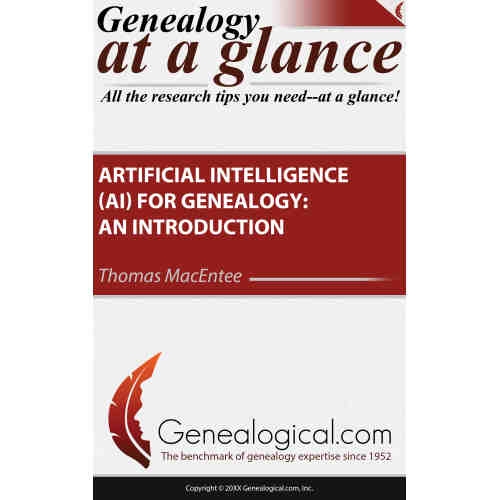Written by AI expert Thomas MacEntee, this new publication examines the rapid growth of Artificial Intelligence in genealogy. According to MacEntee, “AI deals with the simulation of intelligent behavior in computers. AI systems can perform tasks that normally require human intelligence, including visual perception, speech recognition, decision-making, and language translation.” To put it into layman’s terms, if you’ve ever gotten a ticket in the mail for speeding or running a red light when no policeman was present, you’ve experienced AI.
Mr. MacEntee starts with general information about AI and gradually drills down to its application to genealogy. First, comes a discussion of different AI platforms, such as ChatGPT, which is capable of producing human-like text based on mere fragments of information. AI capabilities can also significantly enhance genealogical research by providing detailed and accurate family histories, streamlining the research processes, and improving the overall family history experience. Here are just a few AI applications for genealogy currently in use:
- Automated Record Matching: AI algorithms quickly analyze large volumes of historical records, identifying matches and connections that might be missed by human researchers.
- Optical Character Recognition (OCR): AI-powered OCR converts scanned documents, such as old handwritten records, into searchable and editable text, making historical data more accessible.
- DNA Analysis: AI analyzes DNA test results, identifies genetic matches, and infers ancestral origins.
- Recommendation Systems: AI suggests potential relatives, documents, or records based on user data and search history, making the research process more intuitive.
The balance of this guide discusses some of the cautionary issues associated with AI. Among them are matters of fair use, and proper source citation. The author then cites a number of pros and cons. On the positive side, AI can establish family connections far faster than humans, whether by translating, transcribing, analyzing, or assimilating it. Conversely, users of AI will may find it difficult to determine the source of AI-driven data, contend with bias, risk copyright infringement, violate other persons’ privacy, and fail to detect false information.
It concludes with a glossary of technical terms users will encounter when using this brave new technology.


